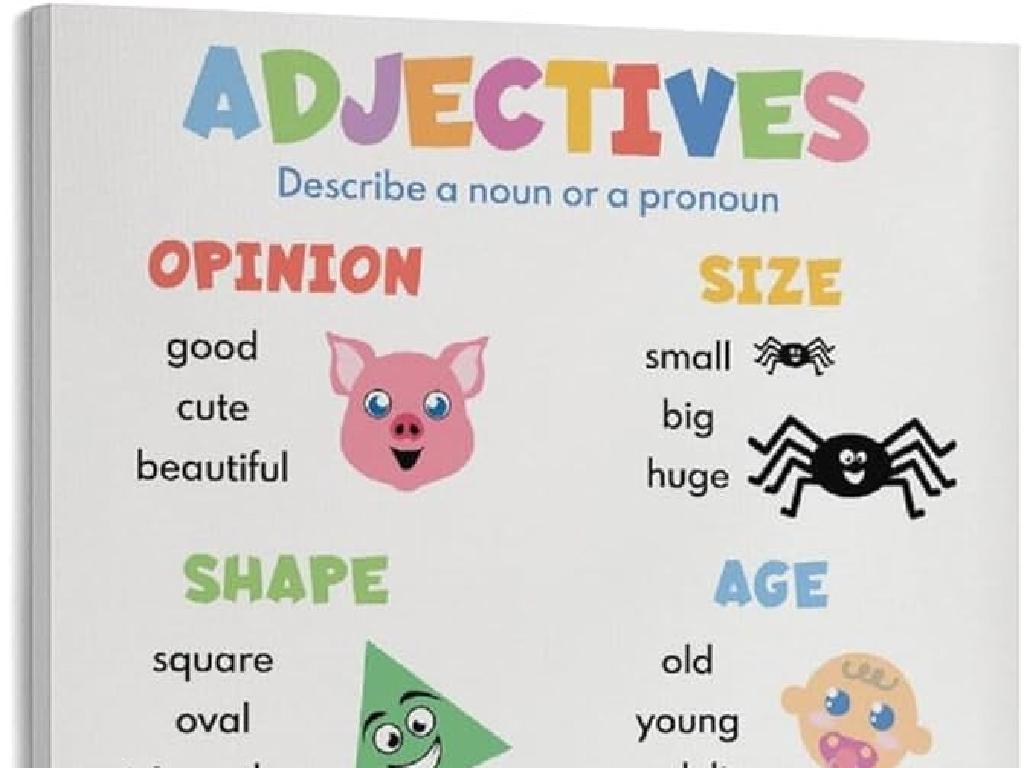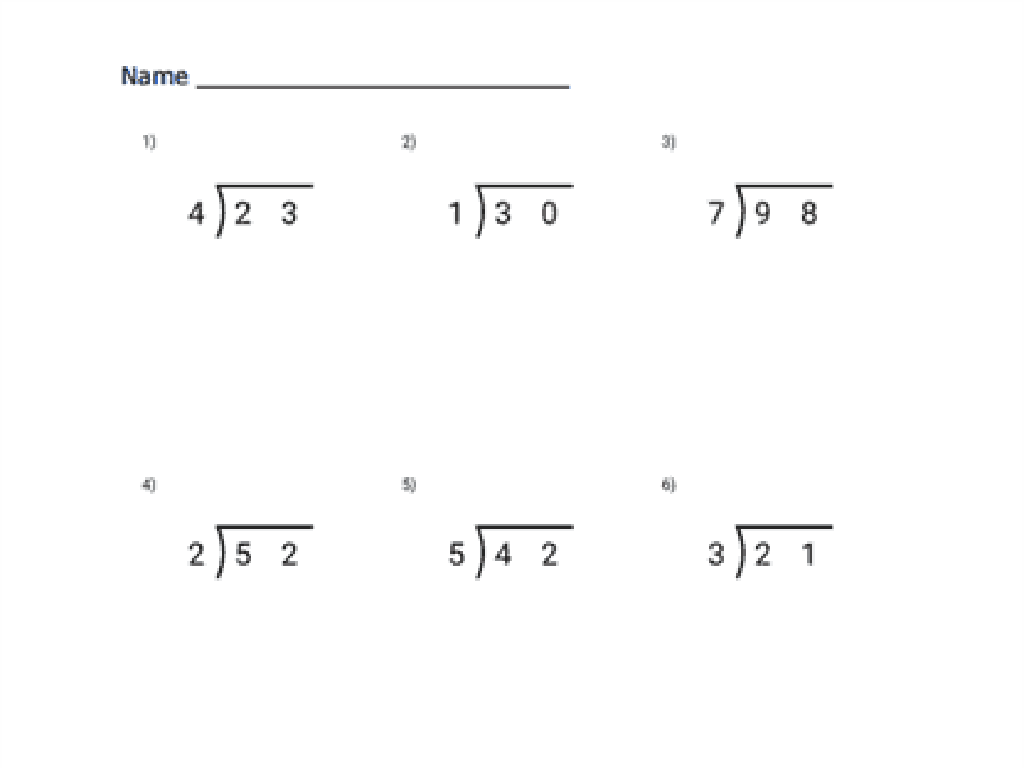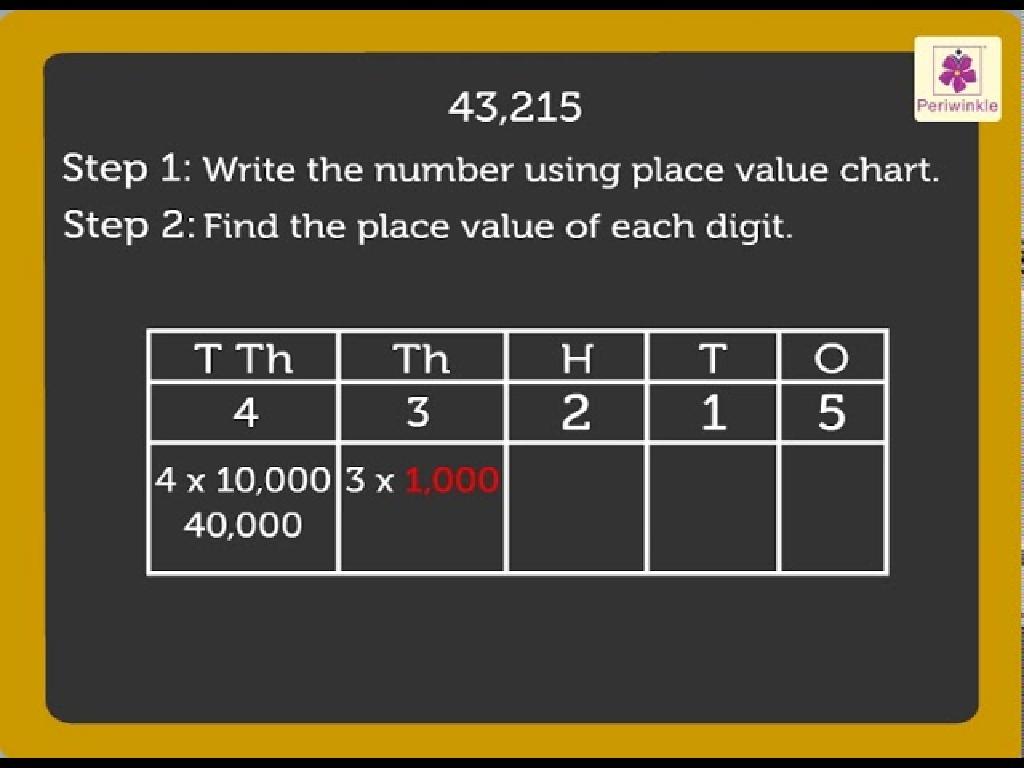Relate Decimals And Money
Subject: Math
Grade: Fourth grade
Topic: Decimals
Please LOG IN to download the presentation. Access is available to registered users only.
View More Content
Welcome to Decimals and Money!
– Decimals in daily life
– Decimals appear in measurements, time, and prices.
– Money as decimals
– Dollars and cents are examples of decimals (e.g., $4.50).
– Today’s goal: Linking decimals and money
– Understand how to read and write money using decimals.
|
This slide introduces the concept of decimals in the context of money, a relevant and tangible example for fourth graders. Begin by explaining how decimals are used in various aspects of everyday life, such as measuring lengths or telling time. Then, focus on money, showing how dollars and cents are a practical representation of decimals. The goal for today’s lesson is for students to confidently connect the concept of decimals with the money they use, such as understanding that $4.50 is the same as 4 dollars and 50 cents. Use examples like price tags and receipts to illustrate this point. Encourage students to think of their own examples of decimals they’ve seen in stores or at home.
Understanding Decimals and Money
– Decimals represent fractions
– Like fractions, decimals show parts of a whole
– Decimals are based on 10
– Each decimal place is a power of 10
– Parts of a Decimal: Whole Number, Decimal Point, Fractional Part
– Whole numbers are left, fractions are right of the decimal point
– Relating Decimals to Money
– Think of dollars as whole numbers and cents as fractions
|
This slide introduces the concept of decimals to fourth-grade students, relating it to their understanding of fractions and money. Decimals are a method of writing fractions in a format that uses the base 10 system, which is the foundation of our number system. Emphasize that the whole number part of a decimal is like the dollars in money, and the fractional part is like the cents, helping students to visualize and understand the concept. Use examples such as $1.25 to show the relationship between decimals and money, where $1 is the whole number part, and .25 represents the fractional part or 25 cents. Encourage students to think of other money amounts and how they can be written as decimals.
Decimals in Money
– Dollars are like whole numbers
– Cents represent parts of a dollar
– Think of cents as the ‘change’ after a dollar
– 100 cents equal 1 dollar
– It’s just like 100 pennies make a dollar
– Relating cents to hundredths
– 100 hundredths (0.01) make up 1 whole (1.00)
|
This slide is designed to help students understand the concept of decimals in the context of money. Explain that dollars are similar to whole numbers and can be related to ‘ones’ in a whole number. Cents are the smaller parts, like the numbers after the decimal point, and there are 100 cents in every dollar, just as there are 100 hundredths in a whole number. Use examples such as $1.25 to show that the 25 cents are the decimal part of the dollar. Encourage students to think of money when they work with decimals to make the concept more tangible and easier to grasp.
Writing Money as Decimals
– Dollars go left of the decimal
– Just like whole numbers in math
– Cents go right of the decimal
– Think of cents as ‘parts’ of a dollar
– Example: $3.50
– $3.50 is the same as 3 dollars and 50 cents
|
This slide aims to teach students how to express monetary values using decimals. Emphasize that the dollars, which are whole amounts, are written to the left of the decimal point, similar to how they write whole numbers in math. The cents, which are parts of a dollar, go to the right of the decimal point, just like how fractions or parts of a whole are represented in decimals. Use the example of $3.50 to show that it represents 3 whole dollars and 50 parts out of 100 of another dollar. Encourage students to practice with different amounts of money, converting them into decimal notation and vice versa, to reinforce the concept.
Adding and Subtracting Money with Decimals
– Line up decimals to add or subtract
– Place the decimal points in a vertical line to ensure accuracy.
– Carry over like whole numbers
– If a column adds up to more than 9, remember to carry over to the next column.
– Practice: $2.75 + $1.50
– Let’s add $2.75 and $1.50 together. What is the total amount?
|
When teaching students to add and subtract money, emphasize the importance of aligning the decimal points to maintain the value of each digit in its correct place value. Compare it to lining up numbers in whole number operations. Use the practice example to walk through the process step by step, showing how to carry over when necessary. Encourage students to think of money in terms of dollars and cents, where the decimal separates the two. After explaining, give them similar problems to solve, ensuring they understand the concept of carrying over and lining up decimals.
Let’s Practice Together: Decimals and Money
– Convert dollars to decimals
– Example: $4.67 is the same as 4.67
– Add two amounts of money
– Example: $5.25 + $2.40 = ?
– Subtract one dollar from another
– Example: $3.50 – $1.00 = ?
– Understanding money as decimals
|
This slide is an interactive class activity designed to help students understand the relationship between money and decimals. Start by explaining that money values can be represented as decimals, where dollars are whole numbers and cents are fractional parts. For the addition and subtraction exercises, guide students through the process step by step, ensuring they align the decimal points correctly. Encourage students to think of money in terms of decimals to strengthen their understanding of both concepts. Provide additional examples if time allows and ensure each student is comfortable with the conversion and calculation process.
Class Activity: Price Tag Fun!
– Create a mini-store in class
– Pair up and label items with prices
– Use stickers or tags to show prices like $1.25, $3.50
– Add prices to find total cost
– Use addition to combine item prices, e.g., $1.25 + $3.50
– Discuss the role of decimals in money
– Understand that decimals in prices represent cents
|
This interactive activity is designed to help students understand the relationship between decimals and money. By creating a mini-store, students will engage in a hands-on experience where they label items with price tags, practicing their understanding of dollars and cents. Working in pairs encourages collaboration and communication. As they add up the prices of their items, they will apply their addition skills and reinforce the concept that decimals are another way to represent parts of a dollar. After the activity, lead a discussion on how decimals are used in everyday money transactions and the importance of understanding decimal places when dealing with currency. Possible variations of the activity could include using different items, offering discounts, or calculating change.
Wrapping Up: Decimals and Money
– Congratulations on learning decimals!
– Homework: Worksheet on money math
– Complete the provided worksheet at home
– Practice adding and subtracting money
– Use your decimal skills to add and subtract amounts
– Keep practicing for perfection!
|
This slide marks the conclusion of our lesson on decimals and money. Reinforce the students’ understanding by congratulating them on their hard work. The homework assignment involves a worksheet that will require them to apply what they’ve learned about decimals to add and subtract money, which is a practical skill they will use in everyday life. Emphasize the importance of practice in mastering these concepts and encourage them to approach the worksheet with confidence. Offer additional support for students who may need it and remind them that practice is key to becoming proficient in working with decimals and money.





